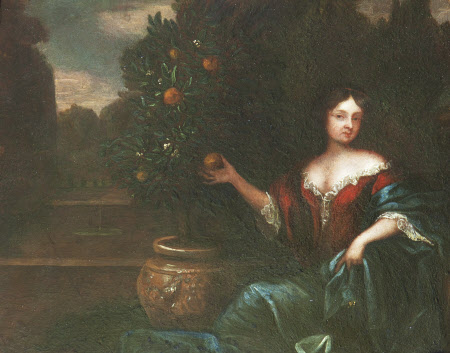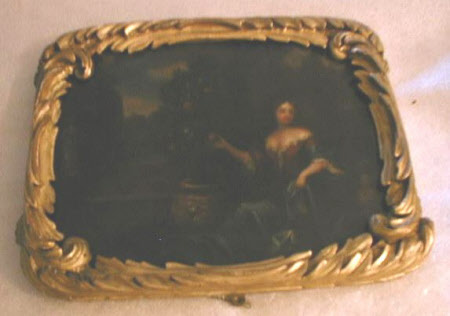Called Elizabeth Freke, Lady Brownlow (1634-1684)
Anglo-Dutch School
Category
Art / Oil paintings
Date
1800 - 1899
Materials
Oil on panel
Measurements
267 x 343 mm (10 1/2 x 13 1/2 in)
Place of origin
England
Order this imageCollection
Belton House, Lincolnshire
NT 436090
Summary
Oil painting on panel, Called Elizabeth Freke, Lady Brownlow (1634-1684), signed bottom right: R.C., Anglo-Dutch School, 19th century. A full-length portrait of a young woman, seated by a potted orange tree, turned to the left, head inclined to the right, gazing at the spectator, painted with a terrace and formal gardens in the background. She was the daughter of John Freke, M.P. of Iwerne Courtney and Cerne Abbas, Dorset (it was John’s 3rd son, and by his 2nd marriage, Thomas I Freke (c.1638-1701), M.P., who owned Shroton, where 'Young' Sir John Brownlow, 3rd Bt., (1659-1697) was to commit suicide) and his second wife, “that soe noble and accomplished Lady”, Jane Shurley, daughter and coheiress of Sir John Shurley, of Isfield, Sussex. Married to Sir Richard Brownlow, 2nd Bt. (1628-1668) in 1652, to whom she bore three sons and seven daughters, of whom only ‘Young’ Sir John Brownlow (1659-1697) and Sir William Brownlow (1665-1702) survived her. She and her husband lived at Ringston Hall, which (now vanished) was presumably near Old Somerby (not to be confused with Tennyson’s natal Somersby), hence the monuments (attributed in The Buildings of England: Lincolnshire to William Stanton) in the church there, to their eldest daughter, Jane Brownlow, who died at the age of 16 in 1670, and to herself, put up by her two surviving sons. Left in great debt by her husband, she had to contest an attempt by ‘Old’ Sir John Brownlow (1594-1679), his uncle, to remove his son and heir, ‘Young’ Sir John, from her care. The inscription on her monument describes her as: “Weary of longer walking in the Wilderness of this World … [in the] 51 year of her early Autumne, Piously and Peaceably her alas! Too short but well past Pilgrimage [was ended].”
Provenance
Purchased with a grant from the National Heritage Memorial Fund (NHMF) from Edward John Peregrine Cust, 7th Baron Brownlow, C. St J. (b.1936) in 1984
Credit line
Belton House, The Brownlow Collection (acquired with the help of the National Heritage Memorial Fund by the National Trust in 1984)
Makers and roles
Anglo-Dutch School, artist R. C., artist

